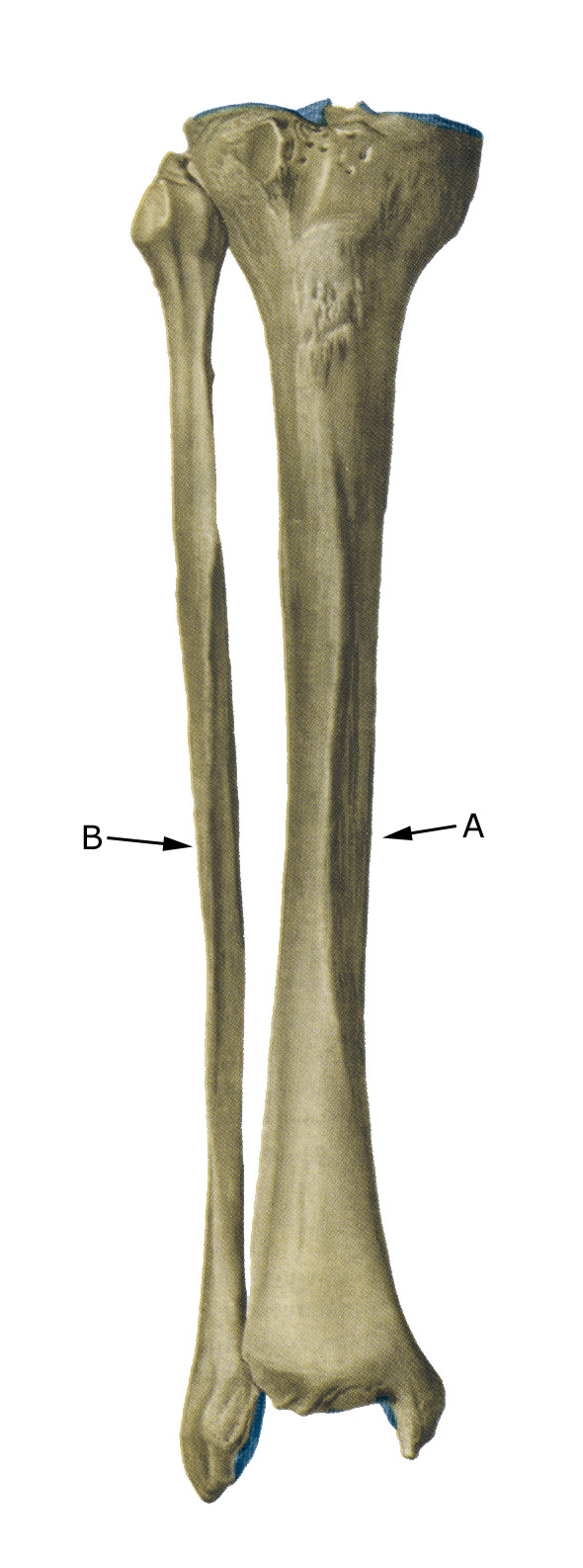Anatomy
 The bones of the lower leg include the tibia and fibula. The two bones form joints both below the knee and above the ankle joint. Between the epiphysis and diaphysis is the epiphyseal disc (growth plate), which is the longitudinal growth zone of the long bone. The epiphyseal disc ossifies at the age of 16-20, whereby longitudinal growth ceases.
The bones of the lower leg include the tibia and fibula. The two bones form joints both below the knee and above the ankle joint. Between the epiphysis and diaphysis is the epiphyseal disc (growth plate), which is the longitudinal growth zone of the long bone. The epiphyseal disc ossifies at the age of 16-20, whereby longitudinal growth ceases.
Front view of the tibia.
A. Tibia
B. Fibula
Cause
Lower leg fractures account for more than one in 10 fractures in children (Weber B, et al. 2021). Most fractures are localised to the lower part of the lower leg. Violent impact or twisting can cause fractures in both the tibia and fibula.
Fractures of the fibula are often seen after kicks to the outside of the lower leg. Fractures are often seen in the epiphyseal disc (epiphysiolysis). As the epiphyseal discs are relatively weaker than the bone tissue itself, fatigue fractures often occur in these and are most common in the lower epiphyseal disc in the tibia just above the ankle.
Symptoms
Pain on pressure (direct and indirect tenderness) and strain (walking and running). There may be swelling and misalignment
Examination
Sudden onset of severe pain in the lower leg with functional impairment and difficulty supporting the leg should always lead to (urgent) medical examination (possibly in hospital). The diagnosis is usually made during a clinical examination.
Rupture of the growth plate (epiphysiolysis) is often overlooked as there is no displacement of the fracture surfaces. X-ray is the primary examination, but ultrasound scans are increasingly used to diagnose fractures (Endara-Mina J, et al. 2023).
MRI and CT scans can be used if there is doubt about the diagnosis.
Treatment
Treatment includes bracing and bandaging (plaster) if the fracture is in an acceptable position. If the fracture is malpositioned, it is set and bandaged. If the fracture surfaces cannot be set or if the fracture is unstable, surgery is often necessary.
Rehabilitation
Treatment includes bracing and bandaging (plaster) if the fracture is in an acceptable position. If the fracture is malpositioned, it is set and bandaged. If the fracture surfaces cannot be set or if the fracture is unstable, surgery is often necessary.
You can expect several months of offloading and rehabilitation before the tibia fracture allows maximum load. It takes longer the older you are.
Plastic bandage
Customised plastic bandages can be manufactured for use during sports activity after various bone fractures. Customised plastic bandages are particularly suitable for fractures of the fibula.
Complications
Severe fractures in the tibia epiphysis close to the knee joint can result in vascular damage that requires emergency treatment. If the fracture surfaces extend into the knee or ankle joint, it can result in permanent damage.
Diaphyseal fractures are complicated in more than one in 10 patients by the development of compartment syndrome requiring emergency treatment (Shore BJ, et al. 2013).
